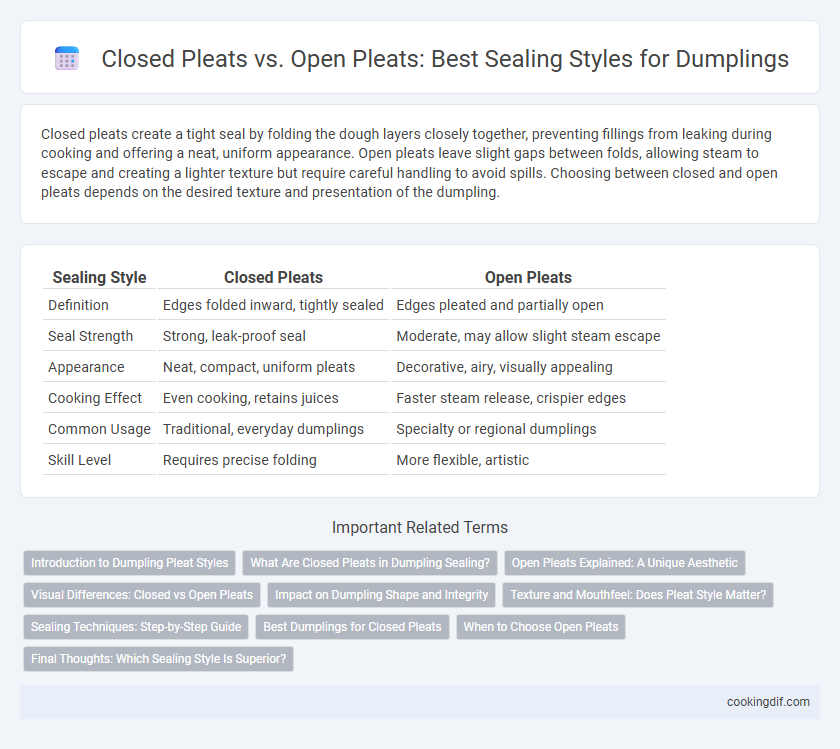Closed pleats create a tight seal by folding the dough layers closely together, preventing fillings from leaking during cooking and offering a neat, uniform appearance. Open pleats leave slight gaps between folds, allowing steam to escape and creating a lighter texture but require careful handling to avoid spills. Choosing between closed and open pleats depends on the desired texture and presentation of the dumpling.
Table of Comparison
| Sealing Style | Closed Pleats | Open Pleats |
|---|---|---|
| Definition | Edges folded inward, tightly sealed | Edges pleated and partially open |
| Seal Strength | Strong, leak-proof seal | Moderate, may allow slight steam escape |
| Appearance | Neat, compact, uniform pleats | Decorative, airy, visually appealing |
| Cooking Effect | Even cooking, retains juices | Faster steam release, crispier edges |
| Common Usage | Traditional, everyday dumplings | Specialty or regional dumplings |
| Skill Level | Requires precise folding | More flexible, artistic |
Introduction to Dumpling Pleat Styles
Closed pleats create a tight seal by folding dough edges over each other, ensuring dumpling fillings remain secure and juices are retained. Open pleats feature a series of outward folds that provide an appealing texture while maintaining a flexible, semi-sealed edge, often preferred in steamed or boiled dumplings. Choosing between closed and open pleats influences not only the dumpling's appearance but also its cooking method and flavor release.
What Are Closed Pleats in Dumpling Sealing?
Closed pleats in dumpling sealing refer to a technique where the dough edges are pinched tightly together, creating small, overlapping folds that completely encase the filling. This sealing method ensures a secure closure, preventing leaks during steaming or boiling, and results in a uniform, crescent-shaped dumpling. Closed pleats are commonly used in traditional Chinese dumplings like jiaozi, enhancing both structural integrity and aesthetic appeal.
Open Pleats Explained: A Unique Aesthetic
Open pleats create a visually striking sealing style for dumplings by folding the dough outward, forming distinct ridges that showcase artisanal craftsmanship. This technique allows steam to escape more easily, resulting in a slightly crisper texture along the edges and enhancing the overall eating experience. Open pleats also provide a unique aesthetic appeal, setting them apart from the more common closed pleats and making each dumpling a miniature work of art.
Visual Differences: Closed vs Open Pleats
Closed pleats create a tightly sealed dumpling with a smooth, continuous edge, giving a neat and compact appearance. Open pleats, on the other hand, form visible folds that expose slight gaps along the seam, resulting in a more decorative and rustic look. The choice between closed and open pleats impacts both the dumpling's visual appeal and the texture of the final dish.
Impact on Dumpling Shape and Integrity
Closed pleats create a tight seal, enhancing dumpling shape by maintaining a uniform, rounded appearance and preventing filling leakage during cooking. Open pleats offer a decorative, handcrafted look but may risk less structural integrity, potentially leading to filling exposure or uneven cooking. Choosing the pleating style directly affects the dumpling's visual appeal and the durability of its seal, influencing overall texture and taste experience.
Texture and Mouthfeel: Does Pleat Style Matter?
Closed pleats create a firmer, more compact texture that holds fillings securely, resulting in a dense mouthfeel ideal for dumplings with moist ingredients. Open pleats, by contrast, allow steam to circulate more freely during cooking, producing a lighter, airier texture and a delicate bite. The choice of pleat style significantly influences the dumpling's tactile experience, impacting how the filling and wrapper meld in each bite.
Sealing Techniques: Step-by-Step Guide
Closed pleats involve folding the dumpling wrapper over the filling and pinching it tightly to create a sealed edge, ensuring no filling escapes during cooking. Open pleats require overlapping the wrapper edges with a series of loose, visible folds, which allows steam to escape and adds a decorative touch. Mastering both sealing techniques involves precise folding, consistent pressure, and practicing even spacing to achieve secure, aesthetically pleasing dumplings.
Best Dumplings for Closed Pleats
Closed pleats create a tight, secure seal that prevents filling leakage, making them ideal for juicy dumplings like pork or chicken with broth. This sealing style enhances structural integrity during boiling or steaming, preserving the dumpling's shape and moisture. Best dumplings for closed pleats include xiao long bao and potstickers, where a robust seal is essential for maintaining the delicate filling and flavorful juices.
When to Choose Open Pleats
Open pleats are ideal for dumplings filled with chunky or delicate ingredients, as this sealing style allows steam to escape without bursting the dough, preserving texture and flavor. This method is especially useful for thicker wrappers or when a rustic, handmade appearance is desired. Choosing open pleats enhances presentation while ensuring even cooking and preventing overfilling.
Final Thoughts: Which Sealing Style Is Superior?
Closed pleats provide a secure and airtight seal, preventing filling leakage during cooking, which is ideal for juicy dumplings like xiao long bao. Open pleats allow for a more decorative appearance and even cooking but may risk slight filling exposure or leakage. For optimal sealing and retaining moisture, closed pleats are generally considered superior in both professional and home dumpling preparation.
Closed pleats vs Open pleats for sealing style Infographic

 cookingdif.com
cookingdif.com